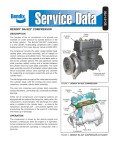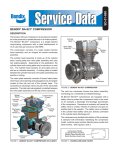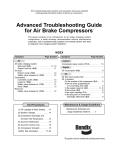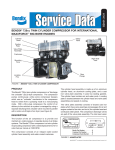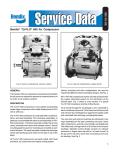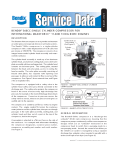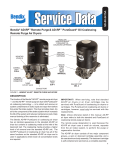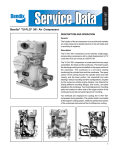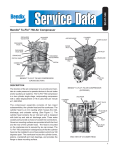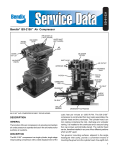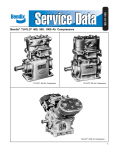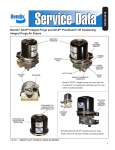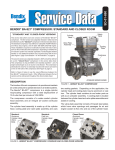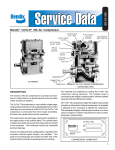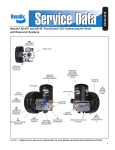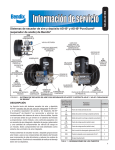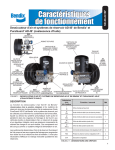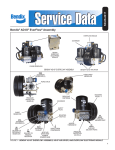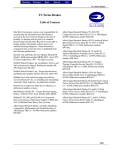Download BENDIX SD-01-670 User's Manual
Transcript
SD-01-670 Š Bendix® DuraFlo 596™ Air Compressor DISCHARGE VALVE DISCHARGE VALVE HOLDER WATER INLET PORT (2) CYLINDER HEAD CYLINDER HEAD VALVE BODY ASSEMBLY WATER OUTLET PORT (1) VALVE BODY ASSEMBLY UNLOADER PORT PISTON PISTON RINGS CRANKCASE CRANKSHAFT DISCHARGE SAFETY VALVE REAR END COVER OIL PORT CRANKCASE CRANKCASE BOTTOM COVER (2) CONNECTING ROD DISCHARGE CAVITY DESCRIPTION The function of the air compressor is to provide and maintain air under pressure to operate devices in the air brake and/or auxiliary air systems. The DuraFlo 596™ compressor is a two cylinder reciprocating compressor with a rated displacement of 27 cubic feet per minute at 1250 RPM. The compressor consists of a water cooled cylinder head and valve body assembly and an air cooled integral crankcase and cylinder block. The cylinder head is an aluminum casting which contains the required air and water ports as well as inlet check valves for each cylinder. The valve body assembly consists of steel upper and lower halves, each of which incorporate various valve openings and channels for conducting air and engine coolant into and out of the cylinder head. The discharge valves for each cylinder are part of the valve body assembly. The valve DISCHARGE VALVE HOLDER DISCHARGE VALVE DISCHARGE PORTS (2) CYLINDER BORE PISTON VIEW OF CYLINDER HEAD AND ONE CYLINDER BORE FIGURE 1 - DURAFLO 596™ AIR COMPRESSOR 1 The DuraFlo 596™ compressor incorporates an unloader system that features an energy saving system or ESS which reduces compressor power consumption by approximately 80% in the unloaded mode. The ESS also reduces compressor oil consumption (oil passing) when the compressor is in the unloaded mode. A nameplate identifying the compressor piece number and serial number is attached to the end of the cylinder block opposite the drive end. OPERATION DETROIT DIESEL CATERPILLAR FIGURE 2 - TYPICAL COMPRESSOR DRIVE FLANGES body assembly is secured to the cylinder head assembly using two cap screws and the cylinder head is secured to the cylinder block with six cap screws. The cylinder head, with the valve body halves, comprise a complete cylinder head assembly. The compressor is driven by the vehicle engine and functions continuously while the engine is in operation. Actual compression of air is controlled by the compressor unloading mechanism operating in conjunction with a remote mounted governor and synchro valve. Unlike the Tu-Flo® compressor series, the DuraFlo 596 ™ compressor requires the addition of a synchro valve to assure proper operation and service life. The governor and synchro valve combination maintains brake system air pressure between a preset maximum and minimum pressure level. Refer to Figure 3. The compressor has a built in unloading and ESS or Energy Saving System. AIR INTAKE (LOADED) The cast iron crankcase and cylinder block assembly, houses the pistons, connecting rods, crankshaft and related bearings. Unloader plungers and related seals and springs are contained in bores in the cylinder block. Sliding inlet valves and their pivot arms are sandwiched between the cylinder block and valve body assembly. AIR DRYER The piston strokes are 180 degrees opposed. As one piston is on an up stroke the opposing piston is on a down stroke. During the piston down stroke, a vacuum is created in the cylinder and ESS chamber within the cylinder head. The vacuum causes the inlet check valve and sliding inlet valve to flex open. Atmospheric air flows through the open inlet check valve into and through the ESS chamber to the sliding inlet valve. Air flowing past the sliding inlet valve fills the cylinder above the piston. See Figures 4 & 7. SYNCHRO VALVE SUPPLY GOVERNOR SYNCHRO VALVE DELIVERY FROM SUPPLY RESERVOIR GOVERNOR (110 CUT-IN 130 CUTOUT) TO COMPRESSOR UNLOADERS TO AIR DRYER DURAFLO™ 596 COMPRESSOR SUPPLY RESERVOIR FIGURE 3 - DURAFLO 596™ AIR COMPRESSOR UNLOADER SYSTEM 2 CONTROL FROM SUPPLY RESERVOIR AIR INLET PORT AIR DISCHARGE PORT INLET CHECK VALVE OPEN AIR INLET PORT INLET CHECK VALVE CLOSED AIR DISCHARGE PORT ESS CHAMBER ESS CHAMBER INLET VALVE OPEN DISCHARGE VALVE CLOSED INLET VALVE OPEN DISCHARGE VALVE CLOSED UNLOADER PISTON PISTON MOVING UP & DOWN PISTON MOVING DOWN UNLOADER PISTON & PIVOT ARM SLIDES INLET VALVE OVER FIGURE 6 - OPERATIONAL-UNLOADED FIGURE 4 - OPERATIONAL-LOADED (INTAKE) AIR COMPRESSION (LOADED) When the piston reaches approximately bottom dead center (BDC) the inlet check valve and sliding inlet valve close. Air above the piston is trapped by the closed inlet valve and is compressed as the piston begins to move toward top dead center (TDC). When air in the cylinder bore reaches a pressure greater than that of the system pressure the discharge valves open and air flows into the discharge line and air brake system. AIR INLET PORT INLET CHECK VALVE CLOSED AIR DISCHARGE PORT ESS CHAMBER INLET VALVE CLOSED DISCHARGE VALVE OPEN UNLOADER PISTON PISTON MOVING UP FIGURE 5 - OPERATIONAL-LOADED (COMPRESSION) NON-COMPRESSION OF AIR (UNLOADED) When air pressure in the supply reservoir reaches the cut-out setting of the governor, the governor delivers system air to the control port of the synchro valve. The synchro valve opens in response to control pressure from the governor and delivers system pressure to either of the two compressor unloader ports. Air entering the unloader port acts on one unloader plunger directly and is simultaneously conducted through a passage in the valve body assembly to the other unloader plunger. The unloader plungers move horizontally in their bores in response to control pressure from the governor and synchro valve. A guide pin in the unloader plunger rotates the pivot arm which causes the inlet valve to slide. As the inlet valve slides from the loaded to the unloaded position it blocks the two discharge ports and opens the six inlet ports connecting the cylinder bore to the ESS chamber. When the piston travels upward, air in the cylinder is trapped between the top of the piston and the closed inlet check valve and is compressed. The intake check valves prevent the intake air from escaping through the air intake port when the compressor is in the unloaded ESS mode. See Figures 5 & 7. The added volume of the ESS chamber lowers the amount of compression. Air that is compressed during the upward movement of the piston provides a driving force for the piston during its downward movement. As one piston is moving downward the opposing piston is moving up. With the exception of losses in the form of heat, which is formed during compression, the energy used to compress the air will be reused as the driving force for the downward stroke of the piston. This results in the compressor using very little power in its unloading position. See Figures 6 & 7. DuraFlo 596™ compressors can also be discharge line unloaded which would eliminate the need for the synchro valve, however, the power savings associated with the ESS system would not be realized. 3 DISCHARGE VALVE air dryer is not used to remove these contaminants prior to entering the air system, the majority, but not all, will condense in the reservoirs. The quantity of contaminants that reach the air system depends on several factors including installation, maintenance and contaminant handling devices in the system. These contaminants must either be eliminated prior to entering the air system or after they enter. INLET PORTS DISCHARGE PORTS CYLINDER HEAD SIDE OF VALVE BODY ASSEMBLY DISCHARGE PORTS INLET PORTS SLIDING INLET VALVES PIVOT ARMS COMPRESSOR LOADED COMPRESSOR UNLOADED CYLINDER BLOCK SIDE OF VALVE BODY ASSEMBLY UNLOADER PORT UNLOADER PLUNGER GUIDE PIN UNLOADER AIR PASSAGE DUTY CYCLE The duty cycle is the ratio of time the compressor spends building air to the total engine running time. Air compressors are designed to build air (run "loaded") up to 25% of the time. Higher duty cycles cause conditions that affect air brake charging system performance which may require additional maintenance. Factors that add to the duty cycle are: air suspension, additional air accessories, use of an undersized compressor, frequent stops, excessive leakage from fittings, connections, lines, chambers or valves, etc. Refer to Table A in the Troubleshooting section for a guide to various duty cycles and the consideration that must be given to maintenance of other components. COMPRESSOR INSTALLATION While the original compressor installation is usually completed by the vehicle manufacturer, conditions of operation and maintenance may require additional consideration. The following presents base guidelines. DISCHARGE LINE PIVOT ARM SLIDING INLET VALVE FIGURE 7 - UNLOADER MECHANISM COMPRESSOR & THE AIR BRAKE SYSTEM GENERAL The compressor is part of the total air brake system, more specifically, the charging portion of the air brake system. As a component in the overall system its condition, duty cycle, proper installation and operation will directly affect other components in the system. Powered by the vehicle engine, the air compressor builds the air pressure for the air brake system. The air compressor is typically cooled by the engine coolant system, lubricated by the engine oil supply and has its inlet connected to the engine induction system. As the atmospheric air is compressed, all the water vapor originally in the air is carried along into the air system, as well as a small amount of the lubricating oil as vapor. If an 4 The discharge line allows the air, water-vapor and oil-vapor mixture to cool between the compressor and air dryer or reservoir. The typical size of a vehicle's discharge line, (see column 2 of Table A in the Troubleshooting section) assumes a compressor with a normal (less than 25%) duty cycle, operating in a temperate climate. See Bendix and/or other air dryer manufacturer guidelines as needed. The discharge line must maintain a constant slope down from the compressor to the air dryer inlet fitting or reservoir to avoid low points where ice may form and block the flow. If, instead, ice blockages occur at the air dryer or reservoir inlet, insulation may be added here, or if the inlet fitting is a typical 90 degree fitting, it may be changed to a straight or 45 degree fitting. Shorter discharge line lengths or insulation may be required in cold climates. While not all compressors and charging systems are equipped with a discharge line safety valve, this component is recommended. The discharge line safety valve is installed in the cylinder head or close to the compressor discharge port and protects against over pressurizing the compressor in the event of a discharge line freeze-up. The Air Brake Charging System supplies the DISCHARGE LINE OPTIONAL “PING” TANK AIR DRYER compressed air for the braking system, as well as other air accessories for the vehicle. The system usually consists of an air compressor, governor, discharge line, air dryer, and service reservoir. OPTIONAL BENDIX® PURAGUARD® QC™ OIL COALESCING FILTER COMPRESSOR GOVERNOR (GOVERNOR PLUS SYNCHRO VALVE FOR THE BENDIX® DURAFLO 596™ COMPRESSOR) SERVICE RESERVOIR (SUPPLY RESERVOIR) RESERVOIR DRAIN FIGURE 8A - SYSTEM DRAWING LUBRICATION HOLE THREAD FIGURE 8B - DISCHARGE LINE SAFETY VALVE The vehicle's engine provides a continuous supply of oil to the compressor. Oil is routed from the engine to the compressor oil inlet. An oil passage in the crankshaft conducts pressurized oil to precision sleeve main bearings and to the connecting rod bearings. Spray lubrication of the cylinder bores, connecting rod wrist pin bushings, and ball type main bearings is obtained as oil is forced out around the crankshaft journals by engine oil pressure. Oil then falls to the bottom of the compressor crankcase and is returned to the engine through drain holes in the compressor mounting flange. COOLING DISCHARGE LINE TEMPERATURE When the temperature of the compressed air that enters the air dryer is within the normal range, the air dryer can remove most of the charging system oil. If the temperature of the compressed air is above the normal range, oil as oil-vapor is able to pass through the air dryer and into the air system. Larger diameter discharge lines and/or longer discharge line lengths can help reduce the temperature. The air dryer contains a filter that collects oil droplets, and a desiccant bed that removes almost all of the remaining water vapor. The compressed air is then passed to the air brake service (supply) reservoir. The oil droplets and the water collected are automatically purged when the governor reaches its "cut-out" setting. For vehicles with accessories that are sensitive to small amounts of oil, we recommend installation of a Bendix® PuraGuard® QC oil coalescing filter, designed to minimize the amount of oil present. Air flowing through the engine compartment from the action of the engine fan and the movement of the vehicle assists in cooling the compressor. Cooling fins are part of the crankcase/cylinder block casting. Coolant flowing from the engine cooling system through connecting lines enters the head and passes through internal passages in the cylinder head and is returned to the engine. Proper cooling is important in maintaining discharge air temperatures below the maximum recommended 400 degrees Fahrenheit. Figure 9 illustrates the various approved coolant flow connections. See the tabulated technical data in the back of this manual for specific requirements. AIR INDUCTION The DuraFlo 596™ compressor is approved for natural aspiration only. The compressor inlet is connected to the vacuum side of the engine air induction system. See the tabulated technical data in the back of this manual for specific requirements. 5 PREVENTATIVE MAINTENANCE Regularly scheduled maintenance is the single most important factor in maintaining the air brake charging system. Refer to Table A in the Troubleshooting section for a guide to various considerations that must be given to the maintenance of the compressor and other related charging system components. Important Note: Review the warranty policy before performing any intrusive maintenance procedures. An extended warranty may be voided if intrusive maintenance is performed during this period. AIR INDUCTION One of the single most important aspects of compressor preventive maintenance is the induction of clean air. Since the DuraFlo 596™ is connected to the engine air cleaner, proper periodic maintenance of the engine air filter eliminates the need for separate filter maintenance. Inspect the compressor intake adapter, and the connecting hoses each time engine air cleaner maintenance is performed. 1. Inspect the intake hose adapters for physical damage. Make certain to check the adapters at both ends of the intake hose or tubing. 2. Inspect the intake hose clamps and tighten them if needed. 3. Inspect the intake hose or line for signs of drying, cracking, chafing and ruptures and replace it if necessary. 13 X 85MM CYL. BOLT (6) COOLANT IN OR OUT (ONE OR THE OTHER PLUGGED) 13 X 60MM CYL. BOLT (2) LIFTING LUG DISCHARGE PORT DISCHARGE SAFETY VALVE INLET PORT COOLANT IN OR OUT CYLINDER HEAD PORT IDENTIFICATION The cylinder head connection ports are identified with cast in numerals as follows: Atmospheric AIR IN 0 Compressed AIR OUT 2 Coolant IN 91 Coolant OUT 92 FIGURE 9 - TYPICAL DURAFLO 596™ AIR COMPRESSOR CYLINDER HEAD 6 EVERY 6 MONTHS, 1800 OPERATING HOURS OR AFTER EACH 50,000 MILES WHICHEVER OCCURS FIRST PERFORM THE FOLLOWING INSPECTIONS AND TESTS. COMPRESSOR COOLING Inspect the compressor discharge port, inlet cavity and discharge line for evidence of restrictions and carboning. If excessive buildup is noted, thoroughly clean or replace the affected parts. Since carbon buildup generally indicates inadequate cooling, closely inspect the compressor cooling system. Check all compressor coolant lines for kinks and restrictions to flow. Minimum coolant line size is 3/8" I.D. Check coolant lines for internal clogging from rust scale. If coolant lines appear suspicious, check the coolant flow and compare to the tabulated technical data present in the back of this manual. Carefully inspect the air induction system for restrictions. LUBRICATION Check the external oil supply line for kinks, bends, or restrictions to flow. Supply lines must be a minimum of 3/16" I.D. Refer to the tabulated technical data in the back of this manual for oil pressure minimum values. Check the exterior of the compressor for the presence of oil seepage and refer to the TROUBLESHOOTING section for appropriate tests and corrective action. OIL PASSING All reciprocating compressors currently manufactured will pass a minimal amount of oil. Air dryers will remove the majority of oil prior to entrance into the air brake system. For particularly oil sensitive systems the Bendix ® PuraGuard ® QC oil coalescing filter can be used in conjunction with a Bendix air dryer. If compressor oil passing is suspected, refer to the TROUBLESHOOTING section and TABLE A for the symptoms and corrective actions to be taken. In addition, Bendix has developed the "Bendix Air System Inspection Cup" or BASIC™ test to help substantiate suspected excessive oil passing. The steps to be followed when using the BASIC™ test are presented in APPENDIX A at the end of the TROUBLESHOOTING section. COMPRESSOR DRIVE Check for noisy compressor operation, which could indicate excessive drive component wear. Adjust and/or replace as necessary. Check all compressor mounting bolts and retighten evenly if necessary. Check for leakage and proper unloader mechanism operation. Repair or replace parts as necessary. COMPRESSOR & GOVERNOR UNLOADER SYSTEM Test and inspect the compressor and governor unloader system for proper operation and pressure setting. 1. Make certain the unloader system contains both the governor and synchro valve as illustrated in Figure 3. 2. Cycle the compressor through the loaded and unloaded cycle several times. Make certain that the governor cuts out at 130 psi (cut-in should be approximately 110 psi). Adjust or replace the governor as required. 3. Note that the DuraFlo 596™ compressor cycles to the loaded and unloaded conditions promptly. This can be definitely confirmed by installing a test gauge in the unused unloader port on the compressor and observing the reaction during transition from the loaded and unloaded condition. Air pressure should be applied and exhausted with a distinct “snap action” with no appreciable lag for buildup or release of pressure. If prompt action is not noted, repair or replace the synchro valve. SERVICE TESTS GENERAL The following compressor operating and leakage tests need not be performed on a regular basis. These tests should be performed when; it is suspected that leakage is substantially affecting compressor buildup performance, or when it is suspected that the compressor is “cycling” between the load and unloaded modes due to unloader plunger leakage. OPERATING TESTS Compressor Performance Vehicles manufactured after the effective date of FMVSS 121 must have a compressor capable of raising air system pressure from 85-100 psi in 25 seconds or less, with the minimum required reservoir volume for the vehicle. This test is performed with the engine operating at maximum recommended governed speed. The vehicle manufacturer must certify this performance on new vehicles with appropriate allowances for air systems with greater than the minimum required reservoir volume. As a less severe alternative to running a high RPM test, a new compressor's buildup time can be measured and recorded at high idle. Subsequent testing throughout the compressor’s service life can be compared to the base line new compressor performance. Compressor buildup times should be recorded and kept with the vehicle maintenance files for reference. When testing compressor buildup times it is essential that air system leakage be kept below the allowed maximum for the vehicle type being tested. Before running buildup tests, check the service and supply systems for excessive leakage and repair as necessary. Note: Supply system leakage is not displayed on the vehicle dash gauges and must be tested separately. Supply system components such as the governor, synchro valve, air dyer, reservoir drain cocks, safety valve and check valves can leak without indication on the dash gauges. These components must be checked for leakage separately and individually. Refer to the various maintenance manuals for individual component leakage tests and the Bendix “Test and Checklist” published in the Air Brake System Handbook (BW5057) for air system leakage testing. LEAKAGE TESTS Cylinder Head Check for cylinder head gasket air leakage. 1. With the engine running, lower air system pressure to 60 psi and apply a soap solution around the cylinder head. Check the gasket between the cylinder head and valve body assembly and the gasket between the valve body assembly and cylinder block for air leakage. 2. No leakage is permitted. If leakage is detected, replace the compressor or repair the cylinder head using a genuine Bendix maintenance kit available from authorized Bendix parts outlets. Inlet, Discharge & Unloader While it is possible to test for inlet, discharge, and unloader plunger leakage it requires disassembly of the cylinder head to accomplish. For this reason it is not recommended. Inlet and discharge valve leakage can generally be detected by longer compressor buildup and recovery times. Compare current compressor buildup times with the last several recorded times. Make certain to test for Air system leakage, as described under Operating Tests, before making a determination that performance has been lost. 1. With the engine running, lower air system pressure to 90 psi and raise engine RPM to 1800. Measure and record the time required to raise system pressure from 100 psi to 130 psi. Run this test three times and use the average time. Note: This test should be run with the engine and air system at normal operating temperature (i.e. not cold). 2. Compare the average time recorded in step 1 with previously recorded build up times to evaluate compressor performance. 7 1 9 9 2 26 10 10 11 12 11 25 12 CYLINDER HEAD VALVE BODY ASSEMBLY 7 6 5 7 6 5 4 13 4 14 3 15 16 8 3 17 18 CRANKCASE & CYLINDER BLOCK 23 19 21 20 24 22 31 27 FLANGE MOUNT COMPRESSOR END COVER 30 29 28 Item 1 2 3 4 5 6 7 8 9 10 11 Qty. 6 2 2 2 2 2 2 1 4 4 2 Description 13mm x 85mm Bolt 13mm x 60mm Bolt 10mm x 25mm Bolt Spacer Sleeve Holder Inlet Check Valve Seat Head to Valve Asm. Gskt. 10mm x 25mm Bolt Spacer Sleeve Holder Item 12 13 14 15 16 17 18 19 20 21 22 Qty. 2 2 2 2 2 2 1 1 1 2 2 Description Discharge Valve Sliding Inlet Valve Pivot Arm Stud Guide Pin Guide Pin Vlv. Asm. to Block Gskt. Plug Sealing Washer Unloader Plunger O-Ring Item 23 24 25 26 27 28 29 30 31 Qty 2 2 6 1 2 8 2 1 4 FIGURE 10 - DURAFLO 596™ AIR COMPRESSOR EXPLODED VIEW OF SERVICEABLE PARTS 8 Description Backup Ring Spring 13mm Washer Discharge Safety Valve Base Plate Gasket Base Plate Cap Screw Base Plate End Cover O-Ring 13mm x 20mm Bolt Unloader leakage is exhibited by excessive compressor cycling between the loaded and unloaded condition. 1. With service and supply system leakage below the maximum allowable limits and the vehicle parked, bring system pressure to governor cut-out and allow the engine to idle. 2. The compressor should remain unloaded for a minimum of 5-10 minutes. If compressor cycling occurs more frequently and service and supply system leakage is within tolerance, replace the compressor or repair the compressor unloader system using a genuine Bendix maintenance kit available from authorized Bendix parts outlets. COMPRESSOR REMOVAL & DISASSEMBLY GENERAL The following disassembly and assembly procedure is presented for reference purposes and presupposes that a rebuild or repair of the compressor is being undertaken. Several maintenance kits are available and the instructions provided with these parts and kits should be followed in lieu of the instructions presented here. off and the ignition key should be removed. Where circumstances require that the engine be in operation, EXTREME CAUTION should be used to prevent personal injury resulting from contact with moving, rotating, leaking, heated or electrically charged components. 3. Do not attempt to install, remove, disassemble or assemble a component until you have read and thoroughly understand the recommended procedures. Use only the proper tools and observe all precautions pertaining to use of those tools. 4. If the work is being performed on the vehicle’s air brake system, or any auxiliary pressurized air systems, make certain to drain the air pressure from all reservoirs before beginning ANY work on the vehicle. If the vehicle is equipped with an AD-IS® air dryer system or a dryer reservoir module, be sure to drain the purge reservoir. 5. Following the vehicle manufacturer’s recommended procedures, deactivate the electrical system in a manner that safely removes all electrical power from the vehicle. MAINTENANCE KITS & SERVICE PARTS 6. Never exceed manufacturer’s recommended pressures. Cylinder Head Maintenance Kit. 7. Never connect or disconnect a hose or line containing pressure; it may whip. Never remove a component or plug unless you are certain all system pressure has been depleted. Unloader Maintenance Kit. All components shown in Figure 10 with a key number are available in kits and/or as individual service parts. COMPRESSOR TROUBLESHOOTING IMPORTANT: The troubleshooting contained in this section considers the compressor as an integrated component of the overall air brake charging system and assumes that an air dryer is in use. The troubleshooting presented will cover not only the compressor itself, but also other charging system devices as they relate to the compressor. GENERAL SAFETY GUIDELINES WARNING! PLEASE READ AND FOLLOW THESE INSTRUCTIONS TO AVOID PERSONAL INJURY OR DEATH: When working on or around a vehicle, the following general precautions should be observed at all times. 1. Park the vehicle on a level surface, apply the parking brakes, and always block the wheels. Always wear safety glasses. 8. Use only genuine Bendix ® replacement parts, components and kits. Replacement hardware, tubing, hose, fittings, etc. must be of equivalent size, type and strength as original equipment and be designed specifically for such applications and systems. 9. Components with stripped threads or damaged parts should be replaced rather than repaired. Do not attempt repairs requiring machining or welding unless specifically stated and approved by the vehicle and component manufacturer. 10. Prior to returning the vehicle to service, make certain all components and systems are restored to their proper operating condition. 11. For vehicles with Automatic Traction Control (ATC), the ATC function must be disabled (ATC indicator lamp should be ON) prior to performing any vehicle maintenance where one or more wheels on a drive axle are lifted off the ground and moving. 2. Stop the engine and remove ignition key when working under or around the vehicle. When working in the engine compartment, the engine should be shut 9 REMOVAL These instructions are general and are intended to be a guide. In some cases additional preparations and precautions are necessary. In all cases follow the instructions contained in the vehicle maintenance manual in lieu of the instructions, precautions and procedures presented in this manual. 1. Block the wheels of the vehicle and drain the air pressure from all the reservoirs in the system. 2. Drain the engine cooling system and the cylinder head of the compressor. Identify and disconnect all air, water and oil lines leading to the compressor. 3. Remove as much road dirt and grease from the exterior of the compressor as possible. 4. Remove the discharge and inlet fittings, if applicable, and note their position on the compressor to aid in reassembly. Note: If a cylinder head or unloader maintenance kit is being installed, stop here and proceed to PREPARATION FOR DISASSEMBLY. If replacing the compressor continue. 5. Remove any supporting bracketing attached to the compressor and note their positions on the compressor to aid in reassembly. 6. Remove the flange mounting bolts and remove the compressor from the vehicle. 7. Inspect gear and associated drive parts for visible wear or damage. Since these parts are precision fitted, they must be replaced if they are worn or damaged. If replacing the compressor or replacing the drive gear, remove the drive gear from the compressor crankshaft using a gear puller. 8. If the compressor is being replaced stop here and proceed to "Installing The Compressor" at the end of the assembly procedure. PREPARATION FOR DISASSEMBLY Remove the balance of road dirt and grease from the exterior of the compressor with a cleaning solvent. Before the compressor is disassembled, the following items should be marked to show their relationship when the compressor is assembled. Mark the rear end cover or end cover adapter in relation to the crankcase. Mark the relationship of the cylinder head to the valve body assembly and crankcase and cylinder block assembly. A convenient method to indicate the above relationships is to use a metal scribe to mark the parts with numbers or lines. Do not use marking methods such as chalk that can be wiped off or obliterated during rebuilding. Prior to disassembly make certain that the appropriate kits and or replacement parts are available. Refer to Figure 10 during the entire disassembly and assembly procedure. 10 UNLOADER & INLET VALVE 1. Remove the discharge safety valve (26) from the cylinder head. 2. Remove the unloader port plug and sealing washer (19 & 20). 3. Loosen but do not remove the two 13mm x 60mm bolts (2). 4. Remove the six 13mm x 85mm cylinder head bolts and washers (1 & 25) and tap the head with a soft mallet to break the gasket seal. Lift the cylinder head and valve body assembly off the cylinder block. IMPORTANT NOTE: Do not attempt to separate the two halves of the valve body assembly. Service replacements and gaskets are not available. 5. Remove the metal gasket (18). 6. Remove both sliding inlet valves (13). 7. Remove both pivot arms (14) and pivot arm studs (15). 8. To remove spring tension from the unloader plunger guide pin (16), insert a 1/4” brass dowel into one of the unloader plunger bore and depress the plunger (21) slightly. While holding the plunger (21) depressed, remove the plunger guide pin (16). Slowly extract the dowel rod from the unloader bore until spring tension is relieved. Note: As an alternative, to this procedure an appropriately sized nut or dowel rod can be placed in the unloader bore and the plug (19) installed then removed after the guide pin is removed. 9. Remove the unloader plunger (21), with its o-ring (22) and backup ring (23) from the bore. Remove the unloader spring (24). 10. Repeat steps 7 and 8 for the other unloader plunger. 11. Remove both pivot arm guide pins (17) from the cylinder block. DISCHARGE & INLET CHECK VALVES 1. Remove the two 13mm x 60mm cylinder head bolts (2) and gently tap the head and valve body assembly with a soft mallet to break the gasket seal. Separate the cylinder head and valve body assembly. IMPORTANT NOTE: Do not attempt to separate the two halves of the valve body assembly. Service replacements and gaskets are not available. 2. Remove the gasket (8). 3. Turn the cylinder head over to expose the inlet check valves and remove the 10mm x 25mm inlet check valve bolt (3) that secures the inlet check valve components. Remove the spacer sleeve (4), holder (5), check valve (6) and check valve seat (7). 4. Repeat step 3 for the second inlet check valve assembly. 5. Remove the two 10mm x 25mm discharge valve bolts (9) that secure the discharge check valve components. Remove the spacer sleeve (10), holder (11) and discharge valve (12). 6. Repeat step 5 for the second discharge valve assembly. CRANKCASE COVER 1. Remove the four cap screws (28) securing the crankcase cover (29). Using a soft mallet, gently tap the crankcase cover (29) to break the gasket seal. Scrape off any gasket material (27) from the crankcase and bottom cover or adapter. 2. Repeat step 1 for the second crankcase cover. END COVER OR END COVER ADAPTER 1. Remove the cap screws (31) that secure the rear end cover or end cover adapter to the crankcase. Note: Some compressor models use four cap screws while others use a combination of cap screws and studs. 2. Remove the rear end cover or end cover adapter from the crankcase. Remove the o-ring seal (30) from the end cover if so equipped. OIL PASSAGES Thoroughly clean all oil passages through the end cover or end cover adapter. Inspect the passages with a wire to be sure. Blow the loosened foreign matter out with air pressure. CYLINDER BLOCK UNLOADER BORES Thoroughly clean the unloader bore on both sides of the compressor cylinder block. Make certain not to scratch or gouge the air pressure sealing surfaces of the bores during the cleaning process. INSPECTION OF PARTS CYLINDER HEAD & VALVE BODY 1. Carefully inspect the cylinder head gasket surfaces for deep gouges and nicks. If detected, the compressor must be replaced. 2. Carefully inspect the valve body gasket surfaces for deep gouges and nicks. Pay particular attention to the metal gasket surface. A metal gasket (18) is used between the valve body assembly and cylinder block. This surface must be smooth and free of all but the most minor scratching. If excessive marring or gouging is detected, the compressor must be replaced. All parts should be cleaned in a good commercial grade of solvent and dried prior to inspection. 3. Inspect the cylinder head for cracks or damage. With the cylinder head and head gasket secured to the valve body, apply shop air pressure to one of the coolant ports with all others plugged, and check for leakage by applying a soap solution to the exterior of the head. If leakage is detected in the cylinder head casting, replace the compressor. CYLINDER HEAD END COVER OR END COVER ADAPTER 1. Carefully remove all gasket material adhering to the cylinder head, valve body assembly and cylinder block. Make certain not to deeply scratch or mar the gasket surfaces. Pay particular attention to the gasket surfaces of the aluminum head. Check for cracks and external damage. Check the crankshaft main bearing surface in the end cover or end cover adapter, check for excessive wear and flat spots and replace the end cover if necessary. Check for galling of the oil port threads and replace the end cover or end cover adapter if necessary. Minor thread chasing is permitted but do not “recut” the threads if they are badly damaged. CLEANING OF PARTS GENERAL 2. Remove carbon deposits from the discharge and inlet cavities of the cylinder head and valve body assembly. Make certain the inlet and discharge ports of the valve body assembly are open and clear. 3. Remove rust and scale from the cooling cavities and passages in the head and valve body assembly and use shop air to clear debris from the passages. 4. Make certain the unloader air passages and coolant passages through the valve body are open and clear of contamination. CYLINDER BLOCK 1. Check the cylinder head gasket surface on the cylinder block for nicks, gouges, and marring. A metal gasket is used to seal the cylinder head to the cylinder block. This surface must be smooth and free of all but the most minor scratching. If excessive marring or gouging is detected, the compressor must be replaced. 5. Check the threads in all cylinder head ports for galling. Minor chasing is permitted. 11 ASSEMBLY General Note: All torques specified in this manual are assembly torques and typically can be expected to fall off after assembly is accomplished. Do not re-torque after initial assembly torques fall unless instructed otherwise. A compiled listing of torque specifications is presented at the end of this manual. INCH POUNDS TO FOOT POUNDS To convert inch pounds to foot pounds of torque, divide inch pounds by 12. Example: 12 Inch Pounds = 1 Foot Pound 12 FOOT POUNDS TO INCH POUNDS To convert foot pounds to inch pounds of torque, multiply foot pounds by 12. Example: 1 Foot Pound x 12 = 12 Inch Pounds CRANKCASE COVER 1. Position one of the two crankcase cover gaskets (27) on either the crankcase or crankcase cover and install the crankcase cover (29) using the position marks made prior to disassembly. Tighten the four cap screws (28), securing the crankcase cover to a torque of 101-111 inch pounds for crankcase cover or cover in a crossing pattern after first snugging all 4 screws. 2. Repeat this assembly for the second crankcase cover (29). CRANKCASE END COVER OR END COVER ADAPTER 1. Install the end cover o-ring (30) on the crankcase end cover. 2. Orient the crankcase end cover or end cover adapter to the crankcase using the reference marks made during disassembly. Carefully install the end cover or end cover adapter in the crankcase making certain not to damage the crankshaft bearing surface in it. 3. Install the four 13mm x 20mm end cover or end cover adapter bolts or studs (31) and tighten to 195 to 212 inch pounds. CYLINDER HEAD INLET CHECK VALVES 1. Locate one of the two inlet check valve seats (7) and note that one side is flat while the other has three protruding tabs around the bolt hole. Position one of the two inlet check valves (6) on the inlet check valve seat (7) so that the three positioning and locating tabs interlock with the corresponding tabs on the seat. When properly fitted together, the valve (6) should lay flat against the seat (7) and cover the slotted opening of the seat. 12 2. Locate one of the two inlet check valve holders (5). Place the holder (5) on the inlet check valve (6) making certain that the three indentations around the bolt hole, on the holder, interlock with the tabs on the inlet check valve (5). When properly assembled the seat (7), valve (6) and holder (5) should be parallel and interlocked. 3. Place the three components over one of the two slotted inlet openings in the cylinder head making certain that the bolt holes in the components and head correspond. 4. Insert one of the two 10mm x 25mm bolts (3) through a spacer sleeve (4). Using the bolt and sleeve, secure the assembled seat (7), valve (6) and holder (5) in the cylinder head. Tighten the bolt finger tight and check that the seat (7), valve (6) and holder (5) are still interlocked. This can be done by attempting to rotate the holder (5) and noting that the valve and seat follow and are locked together. 5. Torque the 10mm bolt to 101 to 111 inch pounds. 6. Repeat steps one through five for the other inlet check valve assembly. DISCHARGE VALVES 1. Locate and place one of the two discharge valves (12) on the valve body assembly with its bolt hole corresponding with the threaded hole on the outside edge of the valve body assembly. When correctly placed, the discharge valve (12) will cover the two discharge holes in the valve body assembly. Refer to Figure 11. DISCHARGE VALVE HOLDER GUIDE LUG DISCHARGE VALVE BOLT HOLE VALVE BODY ASSEMBLY FIGURE 11 - DISCHARGE VALVE INSTALLATION 2. Locate one of the two discharge valve holders (11) and install it over the discharge valve (12) so that the free end of the discharge valve (12) is contained between the two guide lugs on the sides of the holder. Refer to Figure 11. 3. Insert one of the four 10mm x 25mm bolts (9) through a spacer sleeve (10). Using the bolt and sleeve, loosely secure one end of the discharge valve (12) and holder (11) to the valve body assembly. Insert a second 10mm x 25mm bolt (9) through a spacer sleeve (10) and loosely secure the other end of the discharge valve (12) and holder (11) to the valve body assembly. Before attempting to tighten the two 10mm bolts make certain the free tip of the discharge valve (12) is not pinched between the holder (11) and the valve body assembly. The valve must be free to flex. 4. Torque the 10mm bolts to 101 to 111 inch pounds. Pivot Arm Stud Valve Body Inlet Valve Pivot Arm Concave Area 5. Repeat steps one through four for the other discharge valve assembly. Cylinder Block UNLOADER PLUNGERS FIGURE 12 - SLIDING INLET VALVE INSTALLATION 1. Install the metal sealing washer (20) on the plug (19) and set aside. 4. Locate one of the sliding inlet valves (13) and place it on a flat surface. Note that there is a concave and convex side in the surface where the small pivot arm stud hole is located. Refer to Figure 11. 2. Install one o-ring (22) and backup ring (23) in the groove of the unloader plunger (21). The backup ring (23) should be installed in the groove so that it is closest to the center of the plunger. 3. Install the unloader plunger return spring (24) in the bore in the end of the unloader plunger (21). 4. Insert the assembled plunger (21) and spring (24) into one of the unloader bores in the cylinder block. When inserting the plunger orient it so that its guide pin hole will be visible through the slotted opening in the cylinder block. 5. Insert a 1/4” brass dowel into the unloader plunger bore and depress the plunger (21) slightly. While holding the plunger (21) depressed, insert the plunger guide pin (16) into the slotted opening in the cylinder block and into the unloader plunger until it is fully seated and extends above the top surface of the cylinder block approximately 1/8”. Slowly extract the dowel rod from the unloader bore until spring tension is relieved and the guide pin retains the plunger. Note: The unloader plunger guide pin (16) is larger in diameter and longer than the pivot arm guide pin (17). 6. Repeat steps one through five for the other unloader plunger assembly. INLET VALVES & PIVOT ARMS 1. Install both pivot arm guide pins (17) in the cylinder block. 2. Place the pivot arm studs (15) in their slots in the cylinder block. The head (large diameter) of the stud should be in the slot with the small diameter facing away from the cylinder block. 5. Place the metal gasket (18) on the cylinder block, red side toward the cylinder block, while aligning the cylinder head bolt holes. 6. Install the sliding inlet valves (13) on the pivot arm stud, concave side toward the cylinder bock. Make certain to center the inlet valves within their openings in the metal gasket (18). Note: The inlet valves must not be pinched between the metal gasket and the cylinder block. They must be free to slide within their openings in the metal gasket. VALVE BODY & CYLINDER HEAD 1. Orient and carefully install the valve body assembly on the cylinder block. The cylinder block guide pins (17) will locate and guide the installation of the valve body. Note: Try not to disturb the location of the metal gasket (18) during the installation of the valve body because the sliding inlet valves may be pinched. 2. Orient and install the cylinder head gasket (8) on the valve body. 3. Orient and carefully install the cylinder head on the valve body assembly. The cylinder block guide pins (17) will locate and guide the installation of the valve body. 4. Insert the six 13mm x 85mm head bolts into the head and tighten each finger tight. 5. Insert the two 13mm x 60mm head bolts into the head and tighten each finger tight. 6. Insert a 1/4” brass dowel into one of the unloader 3. Install both pivot arms (14) over the cylinder block guide pin (17) and unloader plunger guide pin (16) as well as the stud (15). When installed correctly the stud (15) and unloader plunger guide pin (16) will be in the slotted openings of the pivot arm (14). Note: It may be necessary to slightly depress each unloader plunger to allow easy installation of the pivot arms over the guide pins. 13 plunger bore and depress the plunger (21) several times. The plunger (21) should move freely with only spring tension resistance noted. If greater resistance is noted the sliding inlet valve (13) is pinched and the cylinder head and valve body must be removed and the sliding inlet valve (13) must be repositioned within the opening of the meatal gasket (18). Repeat this procedure for the other unloader plunger and sliding inlet valve. 7. Torque the two 13mm x 60mm head bolts to 265 - 292 inch pounds. 8. Beginning with one of the center bolts, torque the six 13mm x 85mm head bolts to 265 - 292 inch pounds using a figure eight pattern. 9. Apply a thread sealant to the assembled plug and sealing washer (19 & 20) and install it in the cylinder block unloader bore that was marked during disassembly. Tighten sufficiently to seal air pressure. INSTALLING THE COMPRESSOR 1. If the compressor was removed for replacement, install the drive components. Torque the crankshaft nut to 120 foot pounds. 2. Install any supporting bracketing on the compressor in the same position noted and marked during removal. 3. Install the gasket on the drive flange of the compressor. Make certain oil supply or return holes in the gasket are properly aligned with the compressor and engine. Gasket sealants are not recommended. Secure the compressor on the engine and tighten the mounting bolts. 4. Install the discharge and inlet fittings, if applicable, in the same position on the compressor noted and marked during disassembly. Make certain the threads are clean and the fittings are free of corrosion. Replace as necessary. 5. Inspect all air, oil, and coolant lines and fittings before reconnecting them to the compressor. Make certain o-ring seals are in good or new condition. Tighten all hose clamps. 6. Clean oil supply line. Before connecting this line to the compressor. Run the engine briefly to be sure oil is flowing freely through the supply line. 7. Before returning the vehicle to service, perform the Operation and Leakage Tests specified in this manual. Pay particular attention to all lines reconnected during installation and check for air, oil, and coolant leaks at compressor connections. Also check for noisy operation. TESTING REBUILT COMPRESSOR In order to properly test a compressor under operating conditions, a test rack for correct mounting, cooling, 14 lubricating, and driving the compressor is necessary. Such tests are not compulsory if the unit has been carefully rebuilt by an experienced person. A compressor efficiency or build up test can be run which is not too difficult. An engine lubricated compressor must be connected to an oil supply line of at least 15 psi. pressure during the test and an oil return line must be installed to keep the crankcase drained. Connect to the compressor discharge port, a reservoir with a volume of 1500 cubic inches, including the volume of the connecting line. With the compressor operating at 2100 RPM., the time required to raise the reservoir(s) pressure from 85 psi to 100 psi should not exceed 5 seconds. During this test, the compressor should be checked for gasket leakage and noisy operation, as well as unloader operation and leakage. If the compressor functions as indicated reinstall on the vehicle connecting all lines as marked in the disassembly procedure. DURAFLO 596™ COMPRESSOR SPECIFICATIONS Typical weight ........................................................ 50 lbs. Number of cylinders ....................................................... 2 Bore size .............................................. 3.465 in. (88 mm) Stroke .................................................. 1.968 in. (50 mm) Calculated displacement at 1250 RPM .............. 27 CFM Flow Capacity @ 2100 RPM & 120 PSI ............... 23 CFM Maximum recommended RPM ....................... 3000 RPM Minimum coolant flow maximum RPM ...... 2.5 Gals./Min. Approximate horsepower required: Loaded 1800 RPM at 120 PSIG ............................ 7.5 HP Unloaded 1800 RPM ............................................. 0.9 HP Maximum inlet air temperature ............................... 250°F Maximum discharge air temperature ...................... 400°F Minimum oil pressure required at engine idling speed ............................................ 15 PSI Minimum oil pressure required at maximum governed engine speed .................... 15 PSI Minimum oil-supply line size ............................. 3/16" I.D. Minimum unloader-line size .............................. 3/16" I.D. Minimum Governor Cutout Pressure .................... 130 PSI TORQUE SPECIFICATIONS Assembly torques in inch pounds (in. Ibs.) 13mm Cylinder head bolts ................................. 265 - 292 10mm Valve bolts ................................................101 -111 Rear end cover or adapter bolts/studs ............. 195 - 212 Bottom cover ..................................................... 97 - 115 Crankshaft nut ............................................. 1200 - 1440 Metric (Detroit Diesel) M12 x 1.5 .................................................................... 222 M16 x 1.5 .................................................................... 386 M22 x 1.5 .................................................................... 531 M27 x 2 ....................................................................... 792 U.S. (Caterpillar) 1/2"-20 UNF ................................................................ 222 3/4"-16 UNF ................................................................ 398 7/8"-14 UNF ................................................................ 531 1 1/16"-12 UNF ........................................................... 792 DIMENSIONAL DATA Port Sizes Metric (Detroit Diesel) Water inlet ........................................................ M16 x 1.5 Water outlet ..................................................... M16 x 1.5 Discharge safety valve ..................................... M16 x 1.5 Air discharge ....................................................... M27 x 2 Unloader port .................................................... M22 x 1.5 Oil inlet (end cover or adapter) ........................ M12 x 1.5 U.S. (Caterpillar) Water inlet ................................................... 3/4"-16 UNF Water outlet ................................................. 3/4"-16 UNF Discharge safety valve ................................. 3/4"-16 UNF Air discharge ........................................... 1 1/16"-12 UNF Unloader port ................................................ 7/8"-14 UNF Oil inlet (end cover or adapter) .................... 1/2"-20 UNF 15 This troubleshooting guide obsoletes and supersedes all previous published troubleshooting information relative to Bendix air compressors. Advanced Troubleshooting Guide for Air Brake Compressors * The guide consists of an introduction to air brake charging system components, a table showing recommended vehicle maintenance schedules, and a troubleshooting symptom and remedy section with tests to diagnose most charging system problems. INDEX Symptom Page Number Air Symptom Page Number Coolant Air brake charging system: Slow build (9.0) . . . . . . . . . . . . . . . . . . 24 - 25 Doesn’t build air (10.0) . . . . . . . . . . . . . . . . . 26 Air dryer: Doesn’t purge (14.0) . . . . . . . . . . . . . . . . . . 27 Safety valve releases air (12.0) . . . . . . . . . . 27 Compressor: Constantly cycles (15.0) . . . . . . . . . . . . . . . 27 Leaks air (16.0) . . . . . . . . . . . . . . . . . . . . . . 28 Safety valve releases air (11.0) . . . . . . . . . . 26 Noisy (18.0) . . . . . . . . . . . . . . . . . . . . . . . . 28 Reservoir: Safety valve releases air (13.0) . . . . . . . . . . 27 Compressor leaks coolant (17.0). . . . . . . . . . . . 28 Test Procedures Maintenance & Usage Guidelines (1) Oil Leakage at Head Gasket . . . 29 (2) System Leakage . . . . . . . . . . . . 29 Engine Oil consumption (6.0) . . . . . . . . . . . . . . . . . . . . 24 Oil Oil Test Card results (1.0) . . . . . . . . . . . . . . . . . 19 Oil is present: On the outside of the compressor (2.0) . . . . 20 At the air dryer purge/exhaust or surrounding area (3.0) . . . . . . . . . . . . . 20 In the supply reservoir (4.0) . . . . . . . . . 21 - 23 At the valves (5.0) . . . . . . . . . . . . . . . . . . . . 23 At air dryer cartridge (7.0) . . . . . . . . . . . . . . 24 In the ping tank or compressor discharge aftercooler (8.0). . . . . . . . . . . . 24 Maintenance Schedule and Usage Guidelines (Table A) . . . . 18 (3) Compressor Discharge and Air Dryer Inlet Temperature . . . 29 (4) Governor Malfunction . . . . . . . . . 30 (5) Governor Control Line . . . . . . . . 30 (6) Compressor Unloader . . . . . . . . 30 BASIC Test Information . . . . . . . 32-34 *This guide is only for vehicles that use desiccant air dryers. 16 Introduction to the Air Brake Charging System Powered by the vehicle engine, the air compressor builds the air pressure for the air brake system. The air compressor is typically cooled by the engine coolant system and lubricated by the engine oil supply. The compressor's unloader mechanism and governor (along with a synchro valve for the Bendix® DuraFlo 596™ air compressor) control the brake system air pressure between a preset maximum and minimum pressure level by monitoring the pressure in the service (or “supply”) reservoir. When the air pressure becomes greater than that of the preset “cut-out”, the governor controls the unloader mechanism of the compressor to stop the compressor from building air and also causes the air dryer to purge. As the service reservoir air pressure drops to the “cut-in” setting of the governor, the governor returns the compressor back to building air and the air dryer to air drying mode. As the atmospheric air is compressed, all the water vapor originally in the air is carried along into the air system, as well as a small amount of the lubricating oil as vapor. The duty cycle is the ratio of time the compressor spends building air to the total engine running time. Air compressors are designed to build air (run “loaded”) up to 25% of the time. Higher duty cycles cause conditions that affect air brake charging system performance which may require additional maintenance. Factors that add to the duty cycle are: air suspension, additional air accessories, use of an undersized compressor, frequent stops, excessive leakage from fittings, connections, lines, chambers or valves, etc. The discharge line allows the air, water-vapor and oil-vapor mixture to cool between the compressor and air dryer. The typical size of a vehicle's discharge line, (see column 2 of Table A on page 18) assumes a compressor with a normal (less than 25%) duty cycle, operating in a temperate climate. See Bendix and/or other air dryer manufacturer guidelines as needed. When the temperature of the compressed air that enters the air dryer is within the normal range, the air dryer can remove most of the charging system oil. If the temperature of the compressed air is above the normal range, oil as oil-vapor is able to pass through the air dryer and into the air system. Larger diameter discharge lines and/or longer discharge line lengths can help reduce the temperature. The discharge line must maintain a constant slope down from the compressor to the air dryer inlet fitting to avoid low points where ice may form and block the flow. If, instead, ice blockages occur at the air dryer inlet, insulation may be added here, or if the inlet fitting is a typical 90 degree fitting, it may be changed to a straight or 45 degree fitting. For more information on how to help prevent discharge line freeze-ups, see Bendix Bulletins TCH-008-021 and TCH-008-022 (see pages 35-37). Shorter discharge line lengths or insulation may be required in cold climates. The air dryer contains a filter that collects oil droplets, and a desiccant bed that removes almost all of the remaining water vapor. The compressed air is then passed to the air brake service (supply) reservoir. The oil droplets and the water collected are automatically purged when the governor reaches its “cut-out” setting. For vehicles with accessories that are sensitive to small amounts of oil, we recommended installation of a Bendix® PuraGuard® system filter, designed to minimize the amount of oil present. The Air Brake Charging System supplies the Discharge Line Optional “Ping” Tank Air Dryer compressed air for the braking system as well as other air accessories for the vehicle. The system usually consists of an air compressor, governor, discharge line, air dryer, and service reservoir. Optional Bendix® PuraGuard® System Filter or PuraGuard® QC™ Oil Coalescing Filter Compressor Governor (Governor plus Synchro valve for the Bendix® DuraFlo 596™ Compressor) Service Reservoir (Supply Reservoir) Reservoir Drain 17 Table A: Maintenance Schedule and Usage Guidelines Regularly scheduled maintenance is the single most important factor in maintaining the air brake charging system. Column 1 Vehicle Used for: Typical Compressors No. of Spec'd Axles Column 2 Discharge Line I.D. Length 1/2 in. 6 ft. Column 3 Recommended Air Dryer Cartridge Replacement1 Column 4 Recommended Reservoir Drain Schedule2 Column 5 Acceptable Reservoir Oil Contents3 at Regular Drain Interval e.g. Line haul single trailer w/o air suspension, air over hydraulic brakes. 5 or less e.g. Line haul single trailer with air suspension, RV, school bus. 5 or less High Air Use e.g. Double/triple trailer, open highway coach, (most) pick-up & delivery, yard or terminal jockey, off-highway, construction, loggers, concrete mixer, dump truck, fire truck. 8 or less Compressor with up to 25% duty cycle e.g. City transit bus, refuse, bulk unloaders, low boys, urban region coach, central tire inflation. 12 or less Bendix® Tu-Flo® 750 air compressor Compressor with up to 25% duty cycle Bendix® BA-921® air compressor Compressor with up to 25% duty cycle For oil carry-over control4 suggested upgrades: 5/8 in. 1/2 in. 9 ft. 9 ft. Every 3 Years For oil carry-over control4 suggested upgrades: 5/8 in. 1/2 in. 5/8 in. 12 ft. Every 2 Years 15 ft. Every Month 5/8 in. 12 ft. For oil carry-over control4 suggested upgrades: 3/4 in. BASIC™ test acceptable range: 3 oil units per month. See appendix A. For the BASIC™ Test Kit: Order Bendix P/N 5013711 BASIC™ test acceptable range: 5 oil units per month. See appendix A. Every Year 15 ft. Footnotes: 1 With increased air demand the air dryer cartridge needs to be replaced more often. 2 Use the drain valves to slowly drain all reservoirs to zero psi. 3 Allow the oil/water mixture to fully settle before measuring oil quantity. 4 To counter above normal temperatures at the air dryer inlet, (and resultant oil-vapor passing upstream in the air system) replace the discharge line with one of a larger diameter and/ or longer length. This helps reduce the air's temperature. If sufficient cooling occurs, the oil-vapor condenses and can be removed by the air dryer. Discharge line upgrades are not covered under warranty. Note: To help prevent discharge line freeze-ups, shorter discharge line lengths or insulation may be required in cold climates. (See Bendix Bulletins TCH-008-021 and TCH-008-022, included in Appendix B, for more information.) 5 For certain vehicles/applications, where turbo-charged inlet air is used, a smaller size compressor may be permissible. 18 Recommended Every Month Max of every 90 days 12 ft. For oil carry-over control4 suggested upgrades: Bendix® BA-922®, or DuraFlo 596™ air compressor Compressor with less than 15% duty cycle Bendix® Tu-Flo® 550 air compressor Low Air Use Note: Compressor and/or air dryer upgrades are recommended in cases where duty cycle is greater than the normal range (for the examples above). For Bendix ® Tu-Flo ® 550 and 750 compressors, unloader service is recommended every 250,000 miles. Air Brake Charging System Troubleshooting How to use this guide: Find the symptom(s) that you see, then move to the right to find the possible causes (“What it may indicate”) and remedies (“What you should do”). Review the warranty policy before performing any intrusive compressor maintenance. Unloader or cylinder head gasket replacement and resealing of the bottom cover plate are usually permitted under warranty. Follow all standard safety procedures when performing any maintenance. GENERAL SAFETY GUIDELINES WARNING! Please read and follow these instructions to avoid personal injury or death: When working on or around a vehicle, the following general precautions should be observed at all times. 1. Park the vehicle on a level surface, apply the parking brakes, and always block the wheels. Always wear safety glasses. 2. Stop the engine and remove ignition key when working under or around the vehicle. When working in the engine compartment, the engine should be shut off and the ignition key should be removed. Where circumstances require that the engine be in operation, EXTREME CAUTION should be used to prevent personal injury resulting from contact with moving, rotating, leaking, heated or electrically charged components. 3. Do not attempt to install, remove, disassemble or assemble a component until you have read and thoroughly understand the recommended procedures. Use only the proper tools and observe all precautions pertaining to use of those tools. 4. If the work is being performed on the vehicle’s air brake system, or any auxiliary pressurized air systems, make certain to drain the air pressure from all reservoirs before beginning ANY work on the vehicle. If the vehicle is equipped with an AD-IS® air dryer system or a dryer reservoir module, be sure to drain the purge reservoir. Symptom: 1.0 Oil Test Card Results Look for: Normal - Charging system is working within normal range. Check - Charging system needs further investigation. 5. Following the vehicle manufacturer’s recommended procedures, deactivate the electrical system in a manner that safely removes all electrical power from the vehicle. 6. Never exceed manufacturer’s recommended pressures. 7. Never connect or disconnect a hose or line containing pressure; it may whip. Never remove a component or plug unless you are certain all system pressure has been depleted. 8. Use only genuine Bendix® replacement parts, components and kits. Replacement hardware, tubing, hose, fittings, etc. must be of equivalent size, type and strength as original equipment and be designed specifically for such applications and systems. 9. Components with stripped threads or damaged parts should be replaced rather than repaired. Do not attempt repairs requiring machining or welding unless specifically stated and approved by the vehicle and component manufacturer. 10. Prior to returning the vehicle to service, make certain all components and systems are restored to their proper operating condition. 11. For vehicles with Automatic Traction Control (ATC), the ATC function must be disabled (ATC indicator lamp should be ON) prior to performing any vehicle maintenance where one or more wheels on a drive axle are lifted off the ground and moving. What it may indicate: What you should do: Not a valid test. Discontinue using this test. Do not use this card test to diagnose compressor "oil passing" issues. They are subjective and error prone. Use only the Bendix Air System Inspection Cup (BASIC) test and the methods described in this guide for advanced troubleshooting. The Bendix® BASIC™ test should be the definitive method for judging excessive oil fouling/oil passing. (See Appendix A, on page 32 for a flowchart and expanded explanation of the checklist used when conducting the BASIC™ test.) Bendix® BASIC™ Test 19 Symptom: What it may indicate: What you should do: 2.0 Oil on the Outside of the Compressor Engine and/or other accessories leaking onto compressor. Find the source and repair. Return the vehicle to service. 2.1 Oil leaking at compressor / engine connections: (a)Leak at the front or rear (fuel pump, etc.) mounting flange. Repair or replace as necessary. If the mounting bolt torques are low, replace the gasket. (b)Leak at air inlet fitting. Replace the fitting gasket. Inspect inlet hose and replace as necessary. (c) Leak at air discharge fitting. Replace gasket or fitting as necessary to ensure good seal. (d)Loose/broken oil line fittings. Inspect and repair as necessary. (a)Excessive leak at head gasket. Go to Test 1 on page 29. (b)Leak at bottom cover plate. Reseal bottom cover plate using RTV silicone sealant. (c) Leak at internal rear flange gasket. Replace compressor. (d)Leak through crankcase. Replace compressor. (e)(If unable to tell source of leak.) Clean compressor and check periodically. 2.2 Oil leaking from compressor: (a) (c) 3.0 Oil at air dryer purge/exhaust or surrounding area 20 Head gasket and rear flange gasket locations. Air brake charging system functioning normally. Air dryers remove water and oil from the air brake charging system. Check that regular maintenance is being performed. Return the vehicle to service. An optional kit (Bendix piece number 5011327 for the Bendix® AD-IS® or AD-IP® air dryers, or 5003838 for the Bendix® AD-9® air dryer) is available to redirect the air dryer exhaust. Symptom: What it may indicate: 4.0 Oil in Supply or Service Reservoir (air dryer installed) ® (If a maintained Bendix PuraGuard® system filter or Bendix® PuraGuard® QC oil coalescing filter is installed, call 1-800-AIR-BRAKE (1-800-247-2725) and speak to a Tech Team member.) What you should do: Maintenance (a) If air brake charging system maintenance has not been performed. That is, reservoir(s) have not been drained per the schedule in Table A on page 18, Column 4 and/or the air dryer maintenance has not been performed as in Column 3. (b) If the vehicle maintenance has been performed as recommended in Table A on page 18, some oil in the reservoirs is normal. (a) See Table A, on page 18, for maintenance schedule information. Drain all air tanks (reservoirs) into the Bendix® BASIC™ test cup. (Bendix kit P/N 5013711). Drain all air tanks and check vehicle at next service interval using the Bendix® BASIC™ test. See Table A on page 18, column 3 and 4, for recommended service schedule. Drain all air tanks into Bendix® BASIC™ test cup (Bendix Air System Inspection Cup). If less than one unit of reservoir contents is found, the vehicle can be returned to service. Note: If more than one oil unit of water (or a cloudy emulsion mixture) is present, change the vehicle's air dryer, check for air system leakage (Test 2, on page 29), stop inspection and check again at the next service interval. See the BASIC™ test kit for full details. If less than one "oil unit" of water (or water/ cloudy emulsion mixture) is present, use the BASIC™ test cup chart on the label of the cup to determine if the amount of oil found is within the acceptable level. If within the normal range, return the vehicle to service. For vehicles with accessories that are sensitive to small amounts of oil, consider a Bendix ® PuraGuard® QC oil coalescing filter. If outside the normal range go to Symptom 4.0(c). Also see the Table A on page 18, column 3 for recommended air dryer cartridge replacement schedule. Duty cycle too high (c) Air brake system leakage. Go to Test 2 on page 29. (d) Compressor may be undersized for the application. See Table A, column 1, on page 18 for recommended compressor sizes. If the compressor is "too small" for the vehicle's role (for example, where a vehicle's use has changed or service conditions exceed the original vehicle or engine OE spec's) then upgrade the compressor. Note: The costs incurred (e.g. installing a larger capacity compressor, etc.) are not covered under original compressor warranty. If the compressor is correct for the vehicle, go to Symptom 4.0 (e). The duty cycle is the ratio of time the compressor spends building air to total engine running time. Air compressors are designed to build air (to "run loaded") up to 25% of the time. Higher duty cycles cause conditions that affect air brake charging system performance which may require additional maintenance. Factors that add to the duty cycle are: air suspension, additional air accessories, use of an undersized compressor, frequent stops, excessive leakage from fittings, connections, lines, chambers or valves, etc. 21 Symptom: What it may indicate: 4.0 Oil in Supply or Service Reservoir* (air dryer installed) (continued) What you should do: Temperature (e) Air compressor discharge and/or air dryer inlet temperature too high. Check temperature as outlined in Test 3 on page 29. If temperatures are normal go to 4.0(h). (f) Insufficient coolant flow. Inspect coolant line. Replace as necessary (I.D. is 1/2"). Inspect the coolant lines for kinks and restrictions and fittings for restrictions. Replace as necessary. (f) Verify coolant lines go from engine block to compressor and back to the water pump. Repair as necessary. (g) Testing the temperature at the discharge fitting. Inspecting the coolant hoses. (g) Restricted discharge line. If discharge line is restricted or more than 1/16" carbon build up is found, replace the discharge line. See Table A, column 2, on page 18 for recommended size. Replace as necessary. The discharge line must maintain a constant slope down from the compressor to the air dryer inlet fitting to avoid low points where ice may form and block the flow. If, instead, ice blockages occur at the air dryer inlet, insulation may be added here, or if the inlet fitting is a typical 90 degree fitting, it may be changed to a straight or 45 degree fitting. For more information on how to help prevent discharge line freezeups, see Bendix Bulletins TCH-008-021 and TCH-008-022 (Appendix B). Shorter discharge line lengths or insulation may be required in cold climates. Kinked discharge line shown. Other (h) Restricted air inlet (not enough air to compressor). Partly collapsed inlet line shown. Check compressor air inlet line for restrictions, brittleness, soft or sagging hose conditions, etc. Repair as necessary. Inlet line size is 3/4 ID. Maximum restriction requirement for compressors is 25 inches of water. Check the engine air filter and service if necessary (if possible, check the air filter usage indicator). *If a maintained Bendix® PuraGuard® system filter or Bendix® PuraGuard® QC oil coalescing filter is installed, call 1-800-AIR-BRAKE (1-800-247-2725) and speak to a Tech Team member. 22 Symptom: 4.0 Oil in Supply or Service Reservoir* (air dryer installed) (continued) What it may indicate: What you should do: Other (cont.) (i) Poorly filtered inlet air (poor air quality to compressor). Check for leaking, damaged or defective compressor air inlet components (e.g. induction line, fittings, gaskets, filter bodies, etc.). Repair inlet components as needed. Note: Dirt ingestion will damage compressor and is not covered under warranty. Inspect the engine air cleaner. (j) Governor malfunction or setting. Go to Test 4 on page 30. (k) Compressor malfunction. If you found excessive oil present in the service reservoir in step 4.0 (b) above and you did not find any issues in steps 4.0 (c) through 4.0 (j) above, the compressor may be passing oil. Replace compressor. If still under warranty, follow normal warranty process. Note: After replacing a compressor, residual oil may take a considerable period of time to be flushed from the air brake system. Crankcase Flooding Consider installing a compressor bottom drain kit (where available) in cases of chronic oil passing where all other operating conditions have been investigated. Bendix compressors are designed to have a 'dry' sump and the presence of excess oil in the crankcase can lead to oil carryover. *If a maintained Bendix® PuraGuard® system filter or Bendix® PuraGuard® QC oil coalescing filter is installed, call 1-800-AIR-BRAKE (1-800-247-2725) and speak to a Tech Team member. 5.0 Oil present at valves (e.g. at exhaust, or seen during servicing). Air brake system valves are required to tolerate a light coating of oil. A small amount of oil does not affect SAE J2024** compliant valves. Check that regular maintenance is being performed and that the amount of oil in the air tanks (reservoirs) is within the acceptable range shown on the Bendix® BASIC™ test cup (see also column 5 of Table A on page 18). Return the vehicle to service. For oil-sensitive systems, see page 17. ** SAE J2024 outlines tests all air brake system pneumatic components need to be able to pass, including minimum levels of tolerance to contamination. Genuine Bendix valves are all SAE J2024 compliant. 23 Symptom: What it may indicate: What you should do: 6.0 Excessive oil consumption in engine. A problem with engine or other engine accessory. See engine service manual. 7.0 Oil present at air dryer cartridge during maintenance. Air brake charging system is functioning normally. The engine service manual has more information. Oil shown leaking from an air dryer cartridge. 24 Air dryers remove water and oil from the air brake charging system. A small amount of oil is normal. Check that regular maintenance is being performed and that the amount of oil in the air tanks (reservoirs) is within the acceptable range shown by the BASIC™ Test (see also column 5 of Table A on page 18). Replace the air dryer cartridge as needed and return the vehicle to service. 8.0 Oil in ping tank or compressor discharge aftercooler. Air brake charging system is functioning normally. Follow vehicle O.E. maintenance recommendation for these components. 9.0 Air brake charging system seems slow to build pressure. (a) A i r b r a k e c h a r g i n g s y s t e m functioning normally. Using dash gauges, verify that the compressor builds air system pressure from 85-100 psi in 40 seconds or less with engine at full governed rpm. Return the vehicle to service. (b) Air brake system leakage. Go to Test 2 on page 29. (c) Compressor may be undersized for the application. See Table A, column 1, on page 18 for some typical compressor applications. If the compressor is "too small" for the vehicle's role, for example, where a vehicle's use has changed, then upgrade the compressor. Note: The costs incurred (e.g. installing a larger capacity compressor, etc.) are not covered under original compressor warranty. (d) Compressor unloader mechanism malfunction. Go to Test 6 on page 30. (e) D a m a g e d c o m p r e s s o r h e a d gasket. An air leak at the head gasket may indicate a downstream restriction such as a freeze-up or carbon blockage and/or could indicate a defective or missing safety valve. Find blockage (go to 9.0(f) for details.) and then replace the compressor. Do not reuse the safety valve without testing. See Symptom 12.0(a). Symptom: 9.0 Air brake charging system seems slow to build pressure. (continued) What it may indicate: What you should do: (f) Restricted discharge line. If discharge line is restricted: By more than 1/16" carbon build up, replace the discharge line (see Table A, column 2, on page 18 for recommended size) and go to Test 3 on page 29. By other restrictions (e.g. kinks). Replace the discharge line. See Table A, column 2, on page 18 for recommended size. Retest for air build. Return vehicle to service or, if problem persists, go to 9.0(a). (f) Dash gauges. Kinked discharge line shown. (g) Restricted air inlet (not enough air to compressor). (g) The discharge line must maintain a constant slope down from the compressor to the air dryer inlet fitting to avoid low points where ice may form and block the flow. If, instead, ice blockages occur at the air dryer inlet, insulation may be added here, or if the inlet fitting is a typical 90 degree fitting, it may be changed to a straight or 45 degree fitting. For more information on how to help prevent discharge line freezeups, see Bendix Bulletins TCH-008-021 and TCH-008-022 (Appendix B). Shorter discharge line lengths or insulation may be required in cold climates. Check compressor air inlet line for restrictions, brittleness, soft or sagging hose conditions, etc. Repair as necessary. Refer to vehicle manufacturer’s guidelines for inlet line size. Check the engine air filter and service if necessary (if possible, check the air filter usage indicator). Partly collapsed inlet line shown. (h) Poorly filtered inlet air (poor air quality to compressor). Check for leaking, damaged or defective compressor air inlet components (e.g. induction line, fittings, gaskets, filter bodies, etc.). Repair inlet components as needed. Note: Dirt ingestion will damage compressor and is not covered under warranty. (i) Compressor malfunction. Replace the compressor only after making certain that none of the preceding conditions, 9.0 (a) through 9.0 (h), exist. 25 Symptom: 10.0 Air charging system doesn’t build air. What it may indicate: (a) Governor malfunction*. Go to Test 4 on page 30. (b) Restricted discharge line. See 9.0(f). (c) Air dryer heater malfunction: exhaust port frozen open. Replace air dryer heater. (d) Compressor malfunction. Replace the compressor only after making certain the preceding conditions do not exist. * Note: For the Bendix® DuraFlo 596™ air compressor, not only the governor, but also the SV-1™ synchro valve used would need to be tested. See Bulletin TCH-001-048. 11.0 Compressor safety valve releases air (Compressor builds too much air). 26 What you should do: (a) Restricted discharge line. Damaged discharge line shown. If discharge line is restricted: By more than 1/16" carbon build up, replace the discharge line (see Table A, column 2, on page 18 for recommended size) and go to Test 3 on page 29. By other restrictions (e.g. kinks). Replace the discharge line. See Table A, column 2, on page 18 for recommended size. The discharge line must maintain a constant slope down from the compressor to the air dryer inlet fitting to avoid low points where ice may form and block the flow. If, instead, ice blockages occur at the air dryer inlet, insulation may be added here, or if the inlet fitting is a typical 90 degree fitting, it may be changed to a straight or 45 degree fitting. For more information on how to help prevent discharge line freezeups, see Bendix Bulletins TCH-008-021 and TCH-008-022 (Appendix B). Shorter discharge line lengths or insulation may be required in cold climates. (b) Downstream air brake system check valves or lines may be blocked or damaged. Inspect air lines and verify check valves are operating properly. (c) Air dryer lines incorrectly installed. Ensure discharge line is installed into the inlet of the air dryer and delivery is routed to the service reservoir. (d) Compressor safety valve malfunction. Verify relief pressure is 250 psi. Replace if defective. (e) Compressor unloader mechanism malfunction. Go to Test 6 on page 30. (f) Governor malfunction. Go to Test 4 on page 30. Symptom: 12.0 Air dryer safety valve releases air. What it may indicate: What you should do: (a) Restriction between air dryer and reservoir. Inspect delivery lines to reservoir for restrictions and repair as needed. (b) Air dryer safety valve malfunction. Verify relief pressure is at vehicle or component manufacturer specifications. Replace if defective. (c) A i r d r y e r m a i n t e n a n c e n o t performed. See Maintenance Schedule and Usage Guidelines (Table A, column 3, on page 18). (d) Air dryer malfunction. Verify operation of air dryer. Follow vehicle O.E. maintenance recommendations and component Service Data information. (e) Improper governor control line installation to the reservoir. Go to Test 5 on page 30. (f) Governor malfunction. Go to Test 4 on page 30. (a) Reservoir safety valve malfunction. Verify relief pressure is at vehicle or component manufacturer's specifications (typically 150 psi). Replace if defective. (b) Governor malfunction. Go to Test 4 on page 30. (c) Compressor unloader mechanism malfunction. Go to Test 6 on page 30. (a) Air dryer malfunction. Verify operation of air dryer. Follow vehicle O.E. maintenance recommendations. (b) Governor malfunction. Go to Test 4 on page 30. (c) Air brake system leakage. Go to Test 2 on page 29. (d) Improper governor control line installation to the reservoir. Go to Test 5 on page 30. (a) A i r b r a k e c h a r g i n g s y s t e m maintenance not performed. Available reservoir capacity may be reduced by build up of water, etc. Drain and perform routine maintenance per Table A, columns 3 & 4, on page 18. (b) Compressor unloader mechanism malfunction. Go to Test 6 on page 30. (c) Air dryer purge valve or delivery check valve malfunction. Verify operation of air dryer. Follow vehicle O.E. maintenance recommendations and component Service Data information. (d) Air brake system leakage. Go to Test 2 on page 29. Air dryer safety valve Technician removes governor. 13.0 Reservoir safety valve releases air 14.0 Air dryer doesn’t purge. (Never hear exhaust from air dryer.) 15.0 Compressor constantly cycles (compressor remains unloaded for a very short time.) 27 Symptom: 16.0 Compressor leaks air Testing for leaks with soap solution. What it may indicate: What you should do: (a) C o m p r e s s o r l e a k s a i r a t connections or ports. Check for leaking, damaged or defective compressor fittings, gaskets, etc. Repair or replace as necessary. (b) Compressor unloader mechanism malfunction. Go to Test 6 on page 30. (c) Damaged compressor head gasket. An air leak at the head gasket may indicate a downstream restriction such as a freezeup or carbon blockage and/or could indicate a defective or missing safety valve. Find blockage (go to 9.0(f) for details.) and then replace the compressor. Do not re-use the safety valve without testing. See Symptom 12.0(a). Head gasket location 17.0 Compressor leaks coolant 18.0 Noisy compressor (Multi-cylinder compressors only) (a) Improperly installed plugs or coolant line fittings. Inspect for loose or over-torqued fittings. Reseal and tighten loose fittings and plugs as necessary. If overtorqued fittings and plugs have cracked ports in the head, replace the compressor. (b) Damaged compressor head gasket. An air leak at the head gasket may indicate a downstream restriction such as a freezeup or carbon blockage and/or could indicate a defective or missing safety valve. Find blockage (go to 9.0(f) for details.) and then replace the compressor. Do not re-use the safety valve without testing. See Symptom 12.0(a). (c) Porous compressor head casting. If casting porosity is detected, replace the compressor. (a) Damaged compressor. Replace the compressor. Other Miscellaneous Areas to Consider This guide attempts to cover most compressor system problems. Here are some rare sources of problems not covered in this guide: • Turbocharger leakage. Lubricating oil from leaking turbocharger seals can enter the air compressor intake and give misleading symptoms. 28 • Where a compressor does not have a safety valve installed, if a partial or complete discharge line blockage has occurred, damage can occur to the connecting rod bearings. Damage of this kind may not be detected and could lead to compressor problems at a later date. Tests Test 1: Excessive Oil Leakage at the Head Gasket Exterior leaks at the head gasket are not a sign that oil is being passed into the air charging system. Oil weepage at the head gasket does not prevent the compressor from building air. Observe the amount of weepage from the head gasket. If the oil is only around the cylinder head area, it is acceptable (return the vehicle to service), but, if the oil weepage extends down to the nameplate area of the compressor, the gasket can be replaced. LOOK FOR WEEPAGE Test 2: Air Brake System and Accessory Leakage Inspect for air leaks when working on a vehicle and repair them promptly. Park the vehicle on level ground and chock wheels. Build system pressure to governor cut-out and allow the pressure to stabilize for one minute. Step 1: Observe the dash gauges for two additional minutes without the service brakes applied. Step 2: Apply the service brakes and allow the pressure to stabilize. Continue holding for two minutes (you may use a block of wood to hold the Test 3: Air Compressor Discharge Temperature and Air Dryer Inlet Temperature* Caution: The temperatures used in this test are not normal vehicle conditions. Above normal temperatures can cause oil (as vapor) to pass through the air dryer into the air brake system. This test is run with the engine at normal operating temperature, with engine at max. rpm. If available, a dyno may be used. 1. Allow the compressor to build the air system pressure to governor cut-in. 2. Pump the brakes to bring the dash gauge pressure to 90 psi. 3. Allow the compressor to build pressure from 95 to 105 psi gauge pressure and maintain this pressure range by cycling the brakes for five (5) minutes. pedal in position.) Observe the dash gauges. If you see any noticeable decrease of the dash air gauge readings (i.e. more than 4 psi, plus two psi for each additional trailer) during either two minute test, repair the leaks and repeat this test to confirm that they have been repaired. Air leaks can also be found in the charging system, parking brakes, and/or other components - inspect and repair as necessary. (* Note that only vehicles that have passed Test 2 would be candidates for this test.) 4. Then, while maintaining max rpm and pressure range, measure and record the surface temperature of the fittings: at the compressor discharge port. (T1). at the air dryer inlet fitting. (T2). Use a touch probe thermocouple for measuring the temperature. 5. See table below. 6. Retest before returning the vehicle to service. T1 T2 Compressor Air Dryer Discharge Inlet Fitting Fitting under 360°F under 200°F Temperatures are within normal range for this test, check other symptoms. Go to 4.0 (h). under 360°F over 200°F This could indicate a discharge line problem (e.g. restriction). Call 1-800-AIR-BRAKE (1-800-247-2725) and speak with our Tech Team. over 360°F – T1 T2 Discharge Line Action Compressor is running hot. Check coolant 4(f) and/or discharge line 4(g). 29 Tests (continued) Test 4: Governor Malfunction 1. Inspect control lines to and from the governor for restrictions (e.g. collapsed or kinked). Repair as necessary. 2. Using a calibrated external gauge in the supply reservoir, service reservoir, or reservoir port of the D-2® governor, verify cut-in and cut-out pressures are within vehicle OEM specification. 3. If the governor is malfunctioning, replace it. Test 5: Governor Control Line 1. Ensure that the governor control line from the reservoir is located at or near the top of the reservoir. (This line, if located near the bottom of the reservoir, can become blocked or restricted by the reservoir contents e.g. water or ice.) 2. Perform proper reservoir drain intervals and air dryer cartridge maintenance per Maintenance Schedule and Usage Guidelines (Table A on page 18). 3. Return the vehicle to service. Test 6: Compressor Unloader Leakage Bendix ® Compressors: Park vehicle, chock wheels, and follow all standard safety procedures. Remove the governor and install a fitting to the unloader port. Add a section of air hose (min 1ft long for a 1/2" diameter line) and a gauge to the fitting followed by a shut-off valve and an air source (shop air or small air tank). Open the shut off and 30 charge the unloader port by allowing air pressure to enter the hose and unload the compressor. Shut off the air supply and observe the gauge. A steady reading indicates no leakage at the unloader port, but a falling reading shows that the unloader mechanism is leaking and needs to be serviced. NOTES 31 Appendix A: Information about the BASIC™ Test Kit (Bendix P/N 5013711) Service writer records info - including the number of days since all air tanks were drained - and fills out symptom checklist. Technician inspects items. days Bendix® Air System Inspection Cup (BASIC™) Test Information START BASIC TEST Park vehicle on LEVEL ground. Chock wheels, drain air from system. Drain contents of ALL air tanks into BASIC™ cup Is there less than one unit of liquid? Vehicle OK. Return vehicle to service. YES END TEST NO Is there more than one unit of: • water, or • cloudy emulsion mixture? Cloudy emulsion mixture YES NO, only oil. Is this a transit vehicle, bulk unloader, or has more than 5 axles? YES, this is a high air use vehicle. Find the point on the label where the number of oil units meets the number of days* since the vehicle's air tanks were last drained. h Hig Low NO, this is a low air use vehicle. YES Find the point on the label where the number of oil units meets the number of days* since the vehicle's air tanks were last drained. Go to the Advanced Troubleshooting Guide to find reason(s) for presence of water h Hig Is the point above the HIGH Air Use line on the cup? Is the point above the LOW Air Use line on the cup? NO H YES Test for air leakage YES Repair leaks and return vehicle to service END TEST 32 Use Test 2: Air Leakage NO (did not know when last with the drained) Re-test ™ BASIC Test after 30 days*** END TEST * If the number of days since the air tanks were drained is unknown - use the 30 day line. ** Note: Typical air dryer cartridge replacement schedule is every 3 yrs/ 300K miles for low air use vehicles and every year/100K miles for high air use vehicles. END TEST YES, number of days was known (30 - 90 days) Replace the Compressor. If under warranty, follow standard procedures. If, after a compressor was already replaced, the vehicle fails the BASIC™ test again, do not replace the compressor**** - use the Advanced Troubleshooting Guide to investigate the cause(s). END TEST Test for air leakage END TEST Vehicle OK. Return vehicle to service. NO Was the number of days since last draining known? Change air dryer cartridge** Re-test with the ™ BASIC Test after 30 days*** YES Use Test 2: Air Leakage NO Low Low Does the vehicle have excessive air leakage? Compressor END TEST NO igh Is this vehicle being re-tested? (after water, etc. was found last time?) *** To get an accurate reading for the amount of oil collected during a 30 day period, ask the customer not to drain the air tanks before returning. (Note that 30-90 days is the recommended air tank drain schedule for vehicles equipped with a Bendix air dryer that are properly maintained.) If, in cold weather conditions, the 30 day air tank drain schedule is longer than the customer's usual draining interval, the customer must determine, based on its experience with the vehicle, whether to participate now, or wait for warmer weather. See the cold weather tips in Bulletins TCH-008-021 and TCH-008-022 (included on pages 35-37 of this document). ****Note: After replacing a compressor, residual oil may take a considerable period of time to be flushed from the air brake system. Appendix A continued: Information about the BASIC™ Test Kit (Bendix P/N 5013711) ® Filling in the Checklist for the Bendix Air System Inspection Cup (BASIC™) Test Note: Follow all standard safety precautions. For vehicles using a desiccant air dryer. The Service Writer fills out these fields with information gained from the customer Number of Days Since Air Tanks Were Last Drained: ________ Date: ___________Vehicle #: ____________ Engine SN __________________________ Vehicle Used for: _______________Typical Load:________ (lbs.) No. of Axles: ____ (tractor) ____ (trailer) No. of Lift Axles: ____ Technician’s Name: ____________________ Checklist for Technician The Service Writer also checks off any complaints that the customer makes to help the Technician in investigating. Have you confirmed complaint? Customer’s Complaint (Please check all that apply) “Relay valve leaks oil / malfunctions” . . . . . . . . no yes* “Dash valve leaks oil / malfunctions” . . . . . . . . no yes* “Air dryer leaks oil”. . . . . . . . . . . . . . . . . . . . . . . . . no yes* “Governor malfunction” . . . . . . . . . . . . . . . . . . . . . no yes* “Oil in gladhands” . . . . . . . . . . . . . . . . . . . . . . . . . no yes* how much oil did you find? ________________________________ “Oil on ground or vehicle exterior” . . . . . . . . . . . . no yes* amount described: ______________________________________ “Short air dryer cartridge life” replaces every: ______________ miles, kms, or months “Oil in air tanks” amount described:_______________________ We will measure amount currently found when we get to step B of the test. “Excessive engine oil loss”amount described: ______________ Is the engine leaking oil? . . . . . . . . . . . . . . . . . . . . no yes* Is the compressor leaking oil? . . . . . . . . . . . . . . . . no yes* Other complaint: ______________________________________ No customer complaint. BASIC™ test starts here: STEP A - Select one: This is a low air use vehicle: Line haul (single trailer) with 5 or less axles, or This is a high air use vehicle: Garbage truck, transit bus, bulk unloader, or line haul with 6 or more axles. Then go to Step B. STEP B - Measure the Charging System Contents 1. Park and chock vehicle on level ground. Drain the air system by pumping the service brakes. 2. Completely drain ALL the air tanks into a single BASIC™ cup. 3. If there is less than one unit of contents total, end the test now and return the vehicle to service. Vehicle passes. 4. If more than one oil unit of water (or a cloudy emulsion mixture) is found: (a) Change the vehicle’s air dryer cartridge Oil - see Footnote 1, Units (b) Conduct the 4 minute leakage test (Step D), (c) STOP the inspection, and check the vehicle again after 30 days - see Footnote 2. Otherwise, go to Step C. STOP + CK. The Technician checks boxes for any of the complaints that can be confirmed. * Note: A confirmed complaint above does NOT mean that the compressor must be replaced. The full BASIC™ test below will investigate the facts. The Technician selects the air use category for the vehicle. This decided which of the two acceptance lines on the cup will be used for the test below. For an accurate test, the contents of all the air tanks on the vehicle should be used. Note for returning vehicles that are being retested after a water/cloudy emulsion mixture was found last time and the air dryer cartridge replaced: If more than one oil unit of water or a cloudy emulsion mixture is found again, stop the BASIC™ test and consult the air dryer's Service Data sheet troubleshooting section. Footnote 1: Note: Typical air dryer cartridge replacement schedule is every 3 yrs/300K miles for low air use vehicles and every year/100K miles for high air use vehicles. Footnote 2: To get an accurate reading for the amount of oil collected during a 30 day period, ask the customer not to drain the air tanks before returning. (Note that 30-90 days is the recommended air tank drain schedule for vehicles equipped with a Bendix air dryer that are properly maintained.) If, in cold weather conditions, the 30 day air tank drain schedule is longer than the customer's usual draining interval, the customer must determine, based on its experience with the vehicle, whether to participate now, or wait for warmer weather. See the cold weather tips in Bulletins TCH-008-021 and TCH-008-022 (included in Appendix B of the advanced troubleshooting guide). 33 Appendix A continued: Information about the BASIC™ Test Kit (Bendix P/N 5013711) ® Filling in the Checklist for the Bendix Air System Inspection Cup (BASIC™) Test 1. Record days since air tanks were last drained. 2. Record amount of oil found: The Technician uses the chart (label) on the BASIC™ test cup to help decide the action to take, based on the amount of oil found. Use the lower acceptance line for low air use vehicles, and upper line for high air use vehicles (from Step A). _________ days _________ units if oil level is at or below If number of days is: acceptance line for number 30-60 days (high air of days use) or if oil level is above 30-90 days (low air use) acceptance line for number of days if oil level is at or below Otherwise . . . 30-day acceptance line (if the number of days is unknown, or outside the limits above) Sixty days since last air tank draining Park the vehicle on level ground and chock wheels. Build system pressure to governor cut-out and allow the pressure to stabilize for one minute. 1: Observe the dash gauges for two additional minutes without the service brakes applied. 2: Apply service brakes for two minutes (allow pressure to stabilize) and observe the dash gauges. If you see any noticeable decrease of the dash air gauge readings repair leaks. Repeat this test to confirm that air leaks have been repaired and return vehicle to service. Please repeat BASIC™ test at next service interval. Note: Air leaks can also be found in the charging system, parking brakes, and/or other components - inspect and repair as necessary. If no air leakage was detected, and if you are conducting this test after completing Step C, go to Step E. STEP E - If no air leakage was detected in Step D 34 Oil Level X STEP D - Air Brake System Leakage Test Note: If the compressor is within warranty period, please follow standard warranty procedures. Attach the completed checklist to warranty claim. Go to Step D Acceptance Lines An oil level of 4 units in a sixty-day period is within the acceptance area (at or below the line) for both low and high air use vehicles. Return the vehicle to service. Replace the compressor. STOP System OK. TEST Return to service. STOP System OK. TEST Return to service. Stop inspection. if oil level is above 30-day Test again STOP acceptance line + CK. after 30 days. See Footnote 2. BASIC™ Test Example The Technician looks for the point where the number of days since the air tanks were drained meets the oil level. If it is at or below the (low or high use) acceptance line, the vehicle has passed the test. If the point is above the line we go to the leakage test. 3. Action to take STEP C - How to Use the BASIC™ Test Note: Follow all standard safety precautions. For vehicles using a desiccant air dryer. Decision point Air leakage is the number one cause of compressors having to pump excessive amounts of air, in turn run too hot and pass oil vapor along into the system. Here the Technician conducts a four-minute test to see if leakage is a problem with the vehicle being tested. The Technician only reaches Step E if the amount of oil found, for the amount of time since the air tanks were last drained exceeds the acceptance level, AND the vehicle passes the four-minute leakage test (no noticeable leakage was detected). Appendix B Technical Bulletin Bulletin No: TCH-008-021 Subject: Effective Date: 3-5-2010 Cancels: PRO-08-21 dated 2-6-2008 Page: 1 of 2 Air Brake System - Cold Weather Operation Tips As the cold weather approaches, operators and fleets alike begin to look to their vehicles with an eye toward “winterization”, and particularly what can be done to guard against air system freeze-up. Here are some basic “Tips” for operation in the cold weather. Engine Idling Avoid idling the engine for long periods of time! In addition to the fact that most engine manufacturers warn that long idle times are detrimental to engine life, winter idling is a big factor in compressor discharge line freeze-up. Discharge line freeze-ups account for a significant number of compressor failures each year. The discharge line recommendations under “Discharge Lines” are important for all vehicles, but are especially so when some periods of extended engine idling can not be avoided. Discharge Lines The discharge line should slope downward from the compressor discharge port without forming water traps, kinks, or restrictions. Cross-overs from one side of the frame rail to the other, if required, should occur as close as possible to the compressor. Dryer Inlet Temperature The dryer inlet air temperature should typically be within the range of no more than 160°F and no less than 45°F above low ambient (surrounding) temperature to prevent freeze-ups. (For example, if low ambient is minus 40°F, the dryer inlet must be above 5°F.) Lower dryer inlet temperatures should be avoided to minimize the risk of freeze-up upstream of the air dryer. Higher temperatures should also be avoided to minimize the risk of heat damage to the air dryer seals and to avoid a loss of drying performance. Compressor Line Size The line size and length is established by the vehicle manufacturer and should not be altered without the vehicle manufacturers approval. As a reference, the line length from the compressor to the air dryer should be less than 16 feet and the minimum line sizes should be as follows: Minimum Length Minimum Application I.D. 6 ft. 1/2 in. Low Compressor Duty Cycle Applications (0-20%) 10 ft. 5/8 in. High Compressor Duty Cycle Applications (20-40%) Line Insulation To guard against freez-ups in Low Duty Cycle applications, the discharge line can be insulated if it is greater than 9 feet in length. The line can only be insulated back to 9 feet and a maximum of 3 feet. For example, if the line is 10 feet, insulate the fitting and the last one foot of the line. If the line is 15 feet, insulate the fitting and the last 3 feet of the line. © 2010 Bendix Commercial Vehicle Systems LLC All rights reserved. 3/2010 Printed in U.S.A. 35 Appendix B: Continued Bulletin No.: TCH-008-021 Effective Date: 3/5/2010 Page: 2 of 2 System Leakage Check the air brake system for excessive air leakage using the Bendix “Dual System Air Brake Test and Check List” (BW1279). Excessive system leakage causes the compressor to “pump” more air and also reduce the life of the air dryer desiccant cartridge. Reservoir Draining (System without an Air Dryer) Routine reservoir draining is the most basic step in reducing the possibility of freeze-up. All reservoirs in a brake system can accumulate water and other contamination and must be drained! The best practice is to drain all reservoirs daily if the air brake system does not include an air dryer. When draining reservoirs; turn the ENGINE OFF and drain ALL AIR from the reservoir, better still, open the drain cocks on all reservoirs and leave them open over night to assure all contamination is drained (reference Service Data Sheet SD-04-400 for Bendix Reservoirs). If automatic drain valves are installed, check their operation before the weather turns cold (reference Service Data Sheet SD-03-2501 for Bendix® DV-2™ Automatic Drain Valves). It should be noted that, while the need for daily reservoir draining is eliminated through the use of an automatic drain valve, periodic manual draining is still required. Reservoir Draining (System with an Air Dryer) Daily reservoir draining should not be performed on systems with an air dryer. This practice will cause the dryer to do excessive work (i.e. build pressure from 0 -130 psi instead of the normal 110-130 psi). Alcohol Evaporator or Injector Systems Bendix Commercial Vehicle Systems LLC discourages the use of alcohol in the air brake system as a means of preventing system freeze-up in cold temperatures. Studies indicate that using alcohol and alcohol based products sold for this purpose removes the lubrication from the components of the air braking system. In addition, the materials used for the internal seals of the air system components may be adversely impacted by the residue that some anti-freeze additives leave behind. Both are detrimental to air system component life expectancy, causing premature wear. Because of this, Bendix® air system components warranty will be void if analysis shows that alcohol was added to the air brake system. Alcohol is not an acceptable substitute for having adequate air drying capacity. If the air dryer is maintained in accordance with the manufacturer’s recommended practices and moisture is found to be present in the system reservoirs, more drying capacity is required. Bendix has several viable options including extended purge air dryers, extended purge tandem dryers in parallel with common control, and air dryers arranged to provide continuous flow as with the Bendix® EverFlow® continuous flow air dryer module. To address concerns with contaminants in trailer air brake systems, the Bendix® Cyclone DuraDrain™ water separator and the Bendix® System-Guard® trailer air dryer are available. Refer to Bendix Technical Bulletin TCH-008-042 “Alcohol in the Air Brake System” for additional information. Air Dryers Make certain air brake system leakage is within the limits stated in BW1279. Check the operation and function of the air dryer using the appropriate Service Data Sheet for the air dryer. Air Dryer Service Data Sheet AD-2® air dryer SD-08-2403 AD-4® air dryer SD-08-2407 ® AD-9 air dryer SD-08-2412 AD-IP® air dryer SD-08-2414 ® AD-IS air dryer ® ® AD-IS EverFlow air dryer SD-08-2417 AD-SP® air dryer SD-08-2415 Cyclone DuraDrain™ water separator SD-08-2402 PuraGuard QC system filter SD-08-187B Trailer System-Guard® air dryer SD-08-2416 ® 36 SD-08-2418 Bendix literature is available to order or download on Bendix.com Appendix B: Continued Technical Bulletin Bulletin No.: TCH-008-022 Subject: Additional Effective Date: 1/1/1994 Page: 1 of 1 Cold Weather Operation Tips for the Air Brake System Last year we published Bulletin TCH-008-021 which provided some guidelines for “winterizing” a vehicle air brake system. Here are some additional suggestions for making cold weather vehicle operation just a little more bearable. Thawing Frozen Air Lines The old saying; “Prevention is the best medicine” truly applies here! Each year this activity accounts for an untold amount of unnecessary labor and component replacement. Here are some Do’s and Don’ts for prevention and thawing. Do’s 1. Do maintain freeze prevention devices to prevent road calls. Don’t let evaporators or injectors run out of methanol alcohol or protection will be degraded. Check the air dryer for proper operation and change the desiccant when needed. 2. Do thaw out frozen air lines and valves by placing the vehicle in a warmed building. This is the only method for thawing that will not cause damage to the air system or its components. 3. Do use dummy hose couplings on the tractor and trailer. 4. Do check for sections of air line that could form water traps. Look for “drooping” lines. Don’ts 1. Do not apply an open flame to air lines and valves. Beyond causing damage to the internal nonmetallic parts of valves and melting or burning non-metallic air lines. WARNING: THIS PRACTICE IS UNSAFE AND CAN RESULT IN VEHICLE FIRE! 2. Do not introduce (pour) fluids into air brake lines or hose couplings (“glad hands”). Some fluids used can cause immediate and severe damage to rubber components. Even methanol alcohol, which is used in Alcohol Evaporators and Injectors, should not be poured into air lines. Fluids poured into the system wash lubricants out of valves, collect in brake chambers and valves and can cause malfunction. Loss of lubricant can affect valve operating characteristics, accelerate wear and cause premature replacement. 3. Do not park a vehicle outside after thawing its air system indoors. Condensation will form in the system and freeze again. Place the vehicle in operation when it is removed to the outdoors. Supporting Air and Electrical Lines Make certain tie wraps are replaced and support brackets are re-assembled if removed during routine maintenance. These items prevent the weight of ice and snow accumulations from breaking or disconnecting air lines and wires. Automatic Drain Valves (System without Air Dryer) As we stated last year, routine reservoir draining is the most basic step (although not completely effective) in reducing the possibility of freeze-ups. While automatic drain valves relieve the operator of draining reservoirs on a daily basis, these valves MUST be routinely checked for proper operation. Don’t overlook them until they fail and a road call is required. 37 38 39 40 BW1845 © 2010 Bendix Commercial Vehicle Systems LLC. All rights reserved. 03/2010 Printed in U.S.A.








































